
UNLIKE the average tarmac-dwelling motorist, a 4x4 adventurer requires a more sophisticated battery setup. For those lured by dirt and remote campsites, a capable cranking battery that’ll reliably fire an engine into life is essential, as is a unit that’ll power a host of campsite essentials for days on end: fridges, lighting, charging docks for the kids’ phones and laptops … the list goes on.
Obviously a stock starting battery isn’t going to have the required juice to start a vehicle and power campsite electrics – cranking batteries are designed to provide short bursts of energy.
Enter the deep-cycle battery. Rather than provide short, strong bursts of power, a deep-cycle battery instead provides consistent power for longer, and they’re ideally used as an auxiliary battery in tandem with the main starting battery, as they’re great for powering campsite accessories for lengthy periods while the starting battery snoozes.
4x4 battery types and sizes
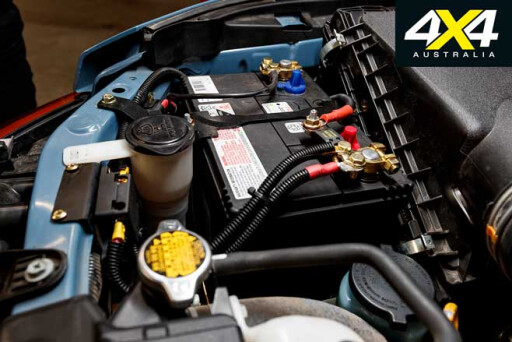
Essentially there are three types of batteries used on the 4x4 scene: starting batteries, dual-purpose batteries (a mixture of starting and semi-cycling abilities) and pure deep-cycle batteries. A quality starting battery, as John Kilby, Century Yuasa Batteries’ national training manager, told us, must be able to cope with “excessive under-bonnet temperatures, continuous vibration and repeated impact from rough and uneven outback roads”.
A dual-purpose battery dabbles in both worlds; it provides enough oomph to fire an engine into life and it can power campsite accessories, provided the 4x4 it’s installed in is on the move every couple of days and the workload is light when the engine isn’t running.
Pure deep-cycle batteries are built for long-term remote adventure, where you can kick back at camp with cold beers, charged electronic equipment and a dormant starting battery – when optimised with a dual-battery setup, of course.
4x4 battery chemistry
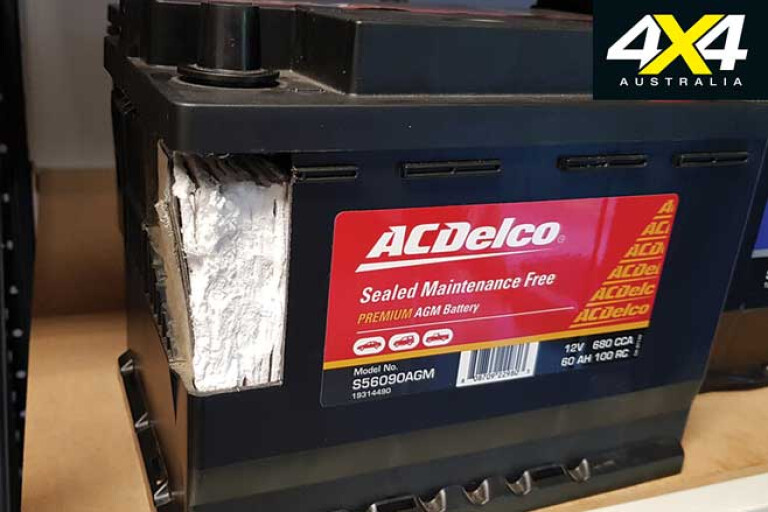
LEAD ACID (FLOODED BATTERIES): The lead is pasted to a plate inside the battery and these are immersed in a battery fluid (electrolyte), which is a mixture of sulphuric acid and water. There are two types of flooded battery available: Low Maintenance, which provides the ability to top-up the battery fluid; and Sealed Maintenance Free (SMF). The term SMF is used when this type of flooded battery is in a container that is sealed and the fluid is unable to be topped up.
AGM (ABSORBED GLASS MAT): In an AGM battery the electrolyte solution is absorbed into glass mat microfibres that are compressed against the plates so there is no loose electrolyte.
GEL: In a Gel battery the electrolyte solution is immobilised in a chemical agent called silica that adheres to the battery plates. Again, there is no loose electrolyte.
Lithium 4x4 battery
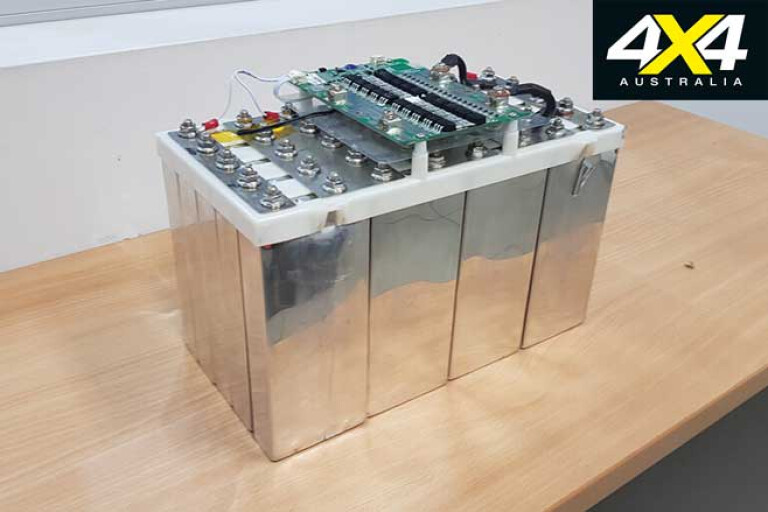
THANKS to their light weight, quicker recharge times and their ability to produce more cycles, lithium batteries are fast becoming all the rage. But what is the difference between a typical Lead Acid battery and a lithium battery, and why are more and more people turning to lithium as a solution? Sealed Performance Batteries is an Australian distributor of Lithium LiFePO4 deep-cycle batteries built for heavy-duty 4x4 use, so we asked marketing manager Callen Price to shed some light on the topic.
“The main difference in the technologies is the base material utilised for the batteries,” he explained. “Both lead acid and lithium contain the standard battery component which includes a cathode, anode, separator and electrolyte; however, lead acid batteries utilise lead for the cathode and anode plates which make them inherently very heavy.
“LiFePO4 utilise LiFePO4 as the cathode and graphite carbon for the anode which make the batteries less than half the weight of the lead acid equivalent. The other large difference is that, with lead acid batteries, a chemical reaction is undertaken during the charge and recharge cycle; whereas with LiFePO4 a transfer of ions is undertaken, which greatly increases the cycle life of LiFePO4 batteries to a point of up to eight times that of lead acid battery.”
Prepare to pay more for the privilege though, with lithium batteries notably more expensive (often five to six times the cost) of lead acid equivalents – although, with their extended running life, a lithium battery can end up being cheaper in the long run. In addition, as lithium batteries are a relatively infant technology they can’t be installed under the bonnet (for overheating reasons). However, they are safe to install inside the cabin or tray.
4x4 battery construction

“When installing additional batteries under the bonnet, it is best to use polypropylene cases, not ABS plastic,” John Kilby from Century Yuasa said. “Polypropylene is designed to cope with the extreme heat, and the benefits of extra electrolyte covering those internals acts like a swimming pool, keeping the battery cool to increase battery life.”
A common misconception in the market is that the cold kills lead acid batteries; however, it is heat that does the damage. Every 10°C increase in temperature doubles the chemical reaction inside a battery, increasing the rate of corrosion and service life
Dual 4x4 battery setups

TWO IS better than one, surely? While running two batteries mightn’t be essential for every 4x4 application, it sure does make off-road life a hell of a lot easier. By using a starter battery in tandem with an auxiliary deep-cycle battery, you can (almost) guarantee you won’t wake up to a flat battery and/or warm beers in the morning.
“A dual-battery system is in itself not essential, for its primary purpose allows the use of creature comforts,” Denis Dwyer, branch manager at Piranha Off Road, told us. “But the secondary gain is that it adds a safety net while in the outback to prevent you from flattening your starting battery; it even acts as a back-up battery if your starting battery should suffer a premature failure.”
Callen Price reiterated that sentiment: “There are two main reasons to have a dual-battery system. One is to run extra equipment like fridges and lights while the 4x4 is not running as the starting battery alone is not designed for those applications. The second is to have the ability to jump-start your vehicle if the main start battery either fails or is flat.”
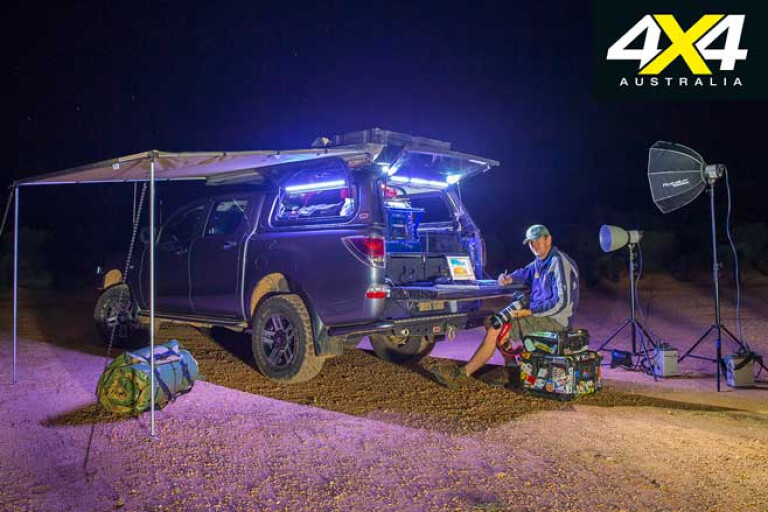
How much electrical charge, or amps, a battery features is also important. For the average weekender, a deep-cycle battery with 80 to 100amp/h is common.
“The camping and 4x4 lifestyle is becoming increasingly popular, though, and with this popularity people are finding themselves staying away from the hustle and bustle for longer periods at a time,” Kahlan Cester from Redarc said. “In order to achieve this freedom, people are moving up to 120, 170, and 200amp/h deep-cycle batteries, with upgrades to LiFePO4 (Lithium) batteries rising at an exponential rate.”
4x4 battery use with solar panels
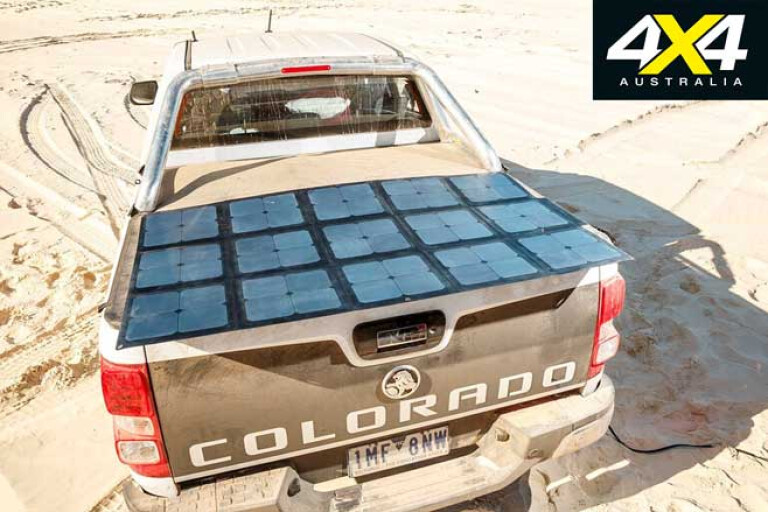
HARNESSING the power of the sun is a great way to recharge your batteries on the run and provide tourers with an alternative means of recharging their batteries to extend the time spent soaking in peace and quiet.
“If you are going to spend some time in the idyllic camp spot where you are unable to plug the big yellow or orange cord into the nearest tree, or you don’t like the purring of a generator, then solar panels are a good investment,” Kilby from Century Yuasa explained. “Particularly now as there some available that fold up and do not consume valuable space in the 4WD.”
Piranha Off Road’s Denis Dwyer added: “With the combination of sun, properly positioned 120-watt panels and a good regulator, your 100-amp/hour battery powering a fridge and LED lights could extend your stay by five days.”
Due to ever-stricter state forest and national park regulations – with increasing restrictions on the use of generators – solar panels will become an even more popular as a source of energy.
4x4 battery smart battery charger

A FLAT battery is good to no-one, and neither is a cooked, overcharged battery. To strike the right balance, a clever piece of tech to invest in is a Smart Charger – 240V AC or 12V DC – which provides the correct voltage or amperage based on the chemistry of the unit (lead acid, AGM, gel or lithium), state of charge and internal resistance.
“If the wrong battery charger is used it could cause the battery to malfunction which may not be covered under warranty,” explained Callen Price.
Redarc stocks the Smart Charger, and the company describes the unit as a multistage rather than a trickle charger: “Where a trickle charger maintains a continuous voltage, a Smart Charger will go through multiple stages such as Boost, Absorption, and Float; with each stage important in recovering a battery without overcharging it.”
4x4 battery DC-DC charger
A DC-DC charger works alongside the vehicle's charging system and primarily ensures an auxiliary battery is maintained at its correct voltage. The unit can also isolate the second battery from the main battery, to ensure the main starter battery doesn't go flat. Most units can supply charging power to both the alternator and portable power.
4x4 battery - What to look out for?
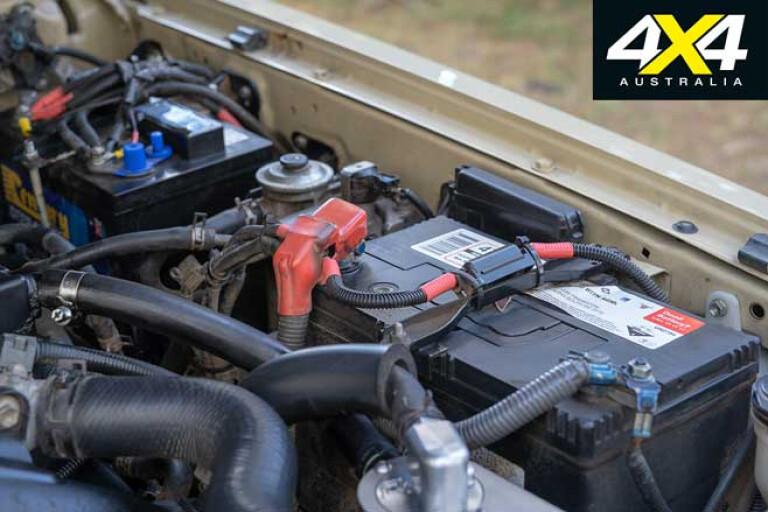
IT’S VITAL to buy 4x4 batteries and accessories that are designed, manufactured and tested in Australia, to be safe in the knowledge that they’ll survive the continent’s harsh and brutal conditions. With heat and vibration the biggest enemies of the 4x4 battery – two things commonly encountered on outback Aussie roads – it’s essential to swipe your credit card for a battery that has robust internal components, and one that can deal with the stress forced upon the plate system.
“Batteries gain extra support on the plate system via a plate lock at the bottom of the plates, which connect it to the case to give extra support,” Callen Price explained. “Others may encase the plate in a sleeve, which protects the plate from shorting the battery if the plate falls due to extreme driving.”
Price also explained AGM batteries contain a glass matting which compacts the plates together, and thus vibration on the plates is drastically reduced.

As touched on, a key difference between a 4x4-specific battery and a starting battery is when comparing battery cycle life versus depth of discharge – how much you can drain the battery without affecting its ability to recover is capacity (80amp/h, 100amp/h, etc.).
“Generally speaking, a standard starting battery such as a maintenance-free lead acid battery should only be discharged to an approximate 80 per cent state of charge,” Kahlan Cester from Redarc said.
“Discharging the battery further can cause one or more of the cells to fail to recover, meaning that it will no longer hold nominal voltage under load. A deep-cycle battery can maintain its advertised cycle life when drained to approximately 50 per cent.”
Once you’ve decided on a setup that suits your requirements, it’s time to ensure it’s maximised to work at its potential and that it’s protected from critical failure. The best way to do this is to utilise a Battery Management System (BMS).
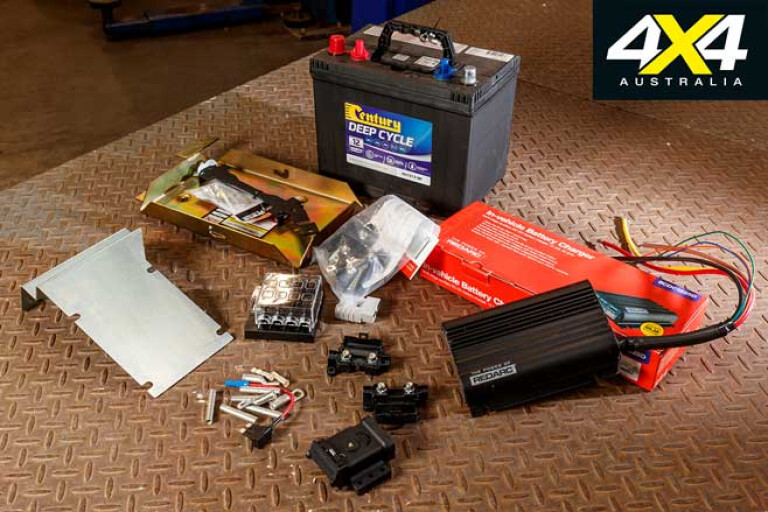
“Outside of monitoring the battery’s status, Battery Management Systems also protect the battery from critical failure caused by over-charge and discharge, over-voltage, over-temperature, short circuit and misuse,” Callen Price from Sealed Performance Batteries said. “However, modern lithium batteries contain an internal BMS system which performs the same critical features as an external system but without the need to install costly equipment. In fact, the internal BMS found on these batteries can connect to your phone via a free app, which allows you to wirelessly monitor your battery and its status.”
A complete Battery Management System can also advise tourers on the most economical ways to use a system and accessories, “so that you can continue your journey without worrying about potential flat batteries,” added Redarc’s Kahlan Cester.
4x4 battery installation
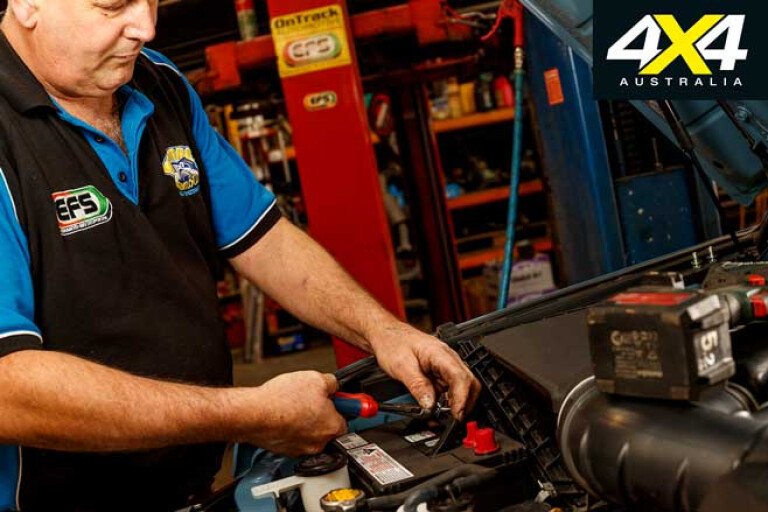
IF deciding to plonk that all-important second battery in your engine bay, you’re going to need to find somewhere to install it – not easy due to overcrowded bays – and something to attach it to.
“The challenge is always finding the real estate to actually locate the auxiliary battery and mounting tray,” explained Piranha’s Denis Dwyer. “The under-bonnet area continues to become more crowded as technology increases, plus the trend for modern cars is to become smaller and lighter.
“This is reflected in the actual internal panel work which means weight becomes a real factor as does the engineering to locate a tray that the manufacturer never expected to allow for.”
The challenge for the aftermarket is to maximise the limited space that’s available in most modern engine bays. A tricky job that’s best left to the experts.
“Compared to past years there are less vehicles that fall into the DIY category, and moving forward with current trends will be even less in a few years’ time. With modern design vehicles, there is peace of mind in having a qualified workshop carry out the install,” Dwyer said.
Piranha Off Road, for example, sells and installs a range of battery trays designed specifically to suit most four-wheel drives currently on the market. When asked if a second battery under-bonnet installation is a DIY possibility, Dwyer told us that it’s getting harder and harder as each year passes.
“Compared to past years, there are fewer vehicles that fall into the DIY category,” he said. “Moving forward with current trends, there will be even less in a few years’ time.”



COMMENTS